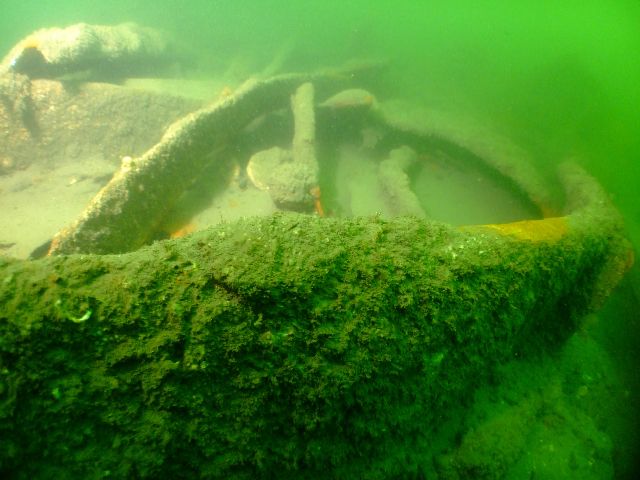6th July 2013
by Richard Booth
With the last week of settled weather and only a few light rain showers, things were looking up for a dive off the Tyne particularly with a forecast of sunshine and light winds. So it was that a party of 7 divers from Durham Divers and Tyneside 114 assembled in the car park with 2 RIB’s.
Once launched the rib’s Sea Hawk and Seaflea headed out of the piers of the Tyne harbour entrance and out to the site of a wreck known locally as the ‘cider wreck’, (on account apparently of a number of old cider jars having been recovered from the surrounding seabed).
Dave Taylor dropped the shot, and with a gentle current still running, in went the first group of divers.

On reaching the bottom we were heartened to see that Dave had managed to plant the shot right between the boiler and the large upright triple expansion engine.

Underwater visibility however was a little disappointing with quite a lot of sediment still hanging in the water. Nevertheless, whilst quite dark you could still see a good 3 to 4 metres, so it was fairly easy to navigate around the wreck site and back to the boilers and the waiting shotline. The best feature of this wreck is the upright steam engine. Numerous Bib fish swim through the rods and pistons. Quite a lot of discarded line and fishing hooks are caught up on this area of wreckage.

For the second dive we headed over to the wreck site of the Oslofjord. Dave again put his shotline in on an area away from the more popular engine room site. Initially on descending down the line only the sandy seabed could be seen.

Nearby investigating a dark shadow and the top of what appeared to be a wheel house half emerging out of the sand. Was this wreckage from another smaller vessel? Small lobsters patrolled around the superstructure, whilst a dahlia anemone strained the water for passing food.

Heading east, we soon came across the collapsed hull of the Oslofjord. Brass gleamed amongst the wreckage.

Moving on, the wreckage became more substantial with areas which one could penetrate into.

Exposed areas were covered in a rich covering of soft corals. Pushing on we came across the side of the hull towering up above the seabed. We had arrived at the bow. The huge anchor winches have been softened by their new covering of marine growth.

The huge chain links now tumble down through the wreckage. Over 70 years of corrosion have taken its toll, and some of the bow area appears to have collapsed over the winter. Nevertheless it still makes for quite a spectacular piece of wreckage to explore. Underwater visibility appeared to be better than that experienced on the earlier dive on the cider wreck.

